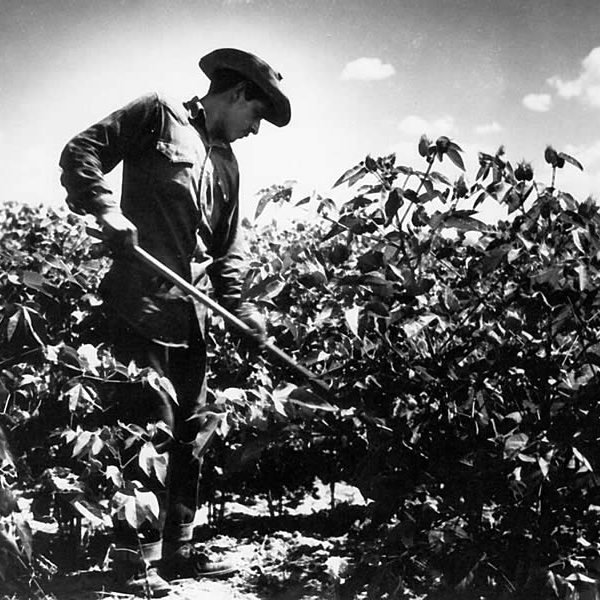Living on a Cotton Farm: Mexican-American Life in Texas

Download lesson plan and included materials
Subject: Social Studies
Grade: 7th
Author: Mary S. Black, translated by Haydeé Rodriguez (2001), TEKS updated by Jason Terry (2023)
Time Duration: Five 50-minute class periods
Overview: This five-day unit plan contains bilingual lessons about twentieth century Mexican-American cotton farming experiences. Topics cover immigration, the twentieth century economy, sharecropping, farm houses, and children's activities. Among the several skills covered are map making and graphing, and handouts and overhead images are provided.
TEKS: Social Studies, Grade 7
Lesson 1 TEKS
- (1A), identify the major eras in Texas history, describe their defining characteristics, and explain the purpose of dividing the past into eras, including Natural Texas and its People; Age of Contact; Spanish Colonial; Mexican National; Revolution and Republic; Early Statehood; Texas in the Civil War and Reconstruction; Cotton, Cattle, and Railroads; Age of Oil; Texas in the Great Depression and World War II; Civil Rights; and Contemporary Texas
- (7A), explain how the oil industry led to the industrialization of Texas;
- (7B), define and trace the impact of "boom-and-bust" cycles of leading Texas industries throughout the 20th and early 21st centuries such as farming, oil and gas production, cotton, ranching, real estate, banking, and computer technology
- (9A), identify ways in which Texans have adapted to and modified the environment and explain the positive and negative consequences of the modifications
- (10A), identify why immigrant groups came to Texas and where they settled;
- (10B), describe how immigration and migration to Texas have influenced Texas
- (20B), analyze information by applying absolute and relative chronology through sequencing, categorizing, identifying cause-and-effect relationships, comparing, contrasting, finding the main idea, summarizing, making generalizations and predictions, and drawing inferences and conclusions
Lesson 2 TEKS
- (10A), identify why immigrant groups came to Texas and where they settled;
- (10B), describe how immigration and migration to Texas have influenced Texas
- (21A), create and interpret thematic maps, graphs, and charts representing various aspects of Texas during the 19th, 20th, and 21st centuries
- (21B), analyze and interpret geographic distributions and patterns in Texas during the 19th, 20th, and 21st centuries
Lesson 3 TEKS
- (10) Geography. The student understands the characteristics, distribution, and migration of population in Texas in the 19th, 20th, and 21st centuries. The student is expected to: (A), identify why immigrant groups came to Texas and where they settled; (B), describe how immigration and migration to Texas have influenced Texas; (C), describe the structure of the population of Texas using demographic concepts such as growth rate and age distribution
- (20A), differentiate between, locate, and use valid primary and secondary sources such as media and news services, biographies, interviews, and artifacts to acquire information about Texas
- (20B), analyze information by applying absolute and relative chronology through sequencing, categorizing, identifying cause-and-effect relationships, comparing, contrasting, finding the main idea, summarizing, making generalizations and predictions, and drawing inferences and conclusions
- (20C), organize and interpret information from outlines, reports, databases, and visuals, including graphs, charts, timelines, and maps
- (21A), create and interpret thematic maps, graphs, and charts representing various aspects of Texas during the 19th, 20th, and 21st centuries; and
- (21B), analyze and interpret geographic distributions and patterns in Texas during the 19th, 20th, and 21st centuries
Lesson 4 TEKS
- (7B), define and trace the impact of "boom-and-bust" cycles of leading Texas industries throughout the 20th and early 21st centuries such as farming, oil and gas production, cotton, ranching, real estate, banking, and computer technology
- (20A), differentiate between, locate, and use valid primary and secondary sources such as media and news services, biographies, interviews, and artifacts to acquire information about Texas
Lesson 5 TEKS
- (20A), compare types and uses of technology, past and present
- (21A), create and interpret thematic maps, graphs, and charts representing various aspects of Texas during the 19th, 20th, and 21st centuries
- (23), Social studies skills. The student uses problem-solving and decision-making skills, working independently and with others. The student is expected to use problem-solving and decision-making processes to identify a problem, gather information, list and consider options, consider advantages and disadvantages, choose and implement a solution, and evaluate the effectiveness of the solution.
Lesson 6 TEKS
- (22C), create written, oral, and visual presentations of social studies information
Activities and Procedures: See attached Unit Plan. Please note that some weblinks in the document no longer work. Non-functioning links are struck through, and one is replaced with an updated link.